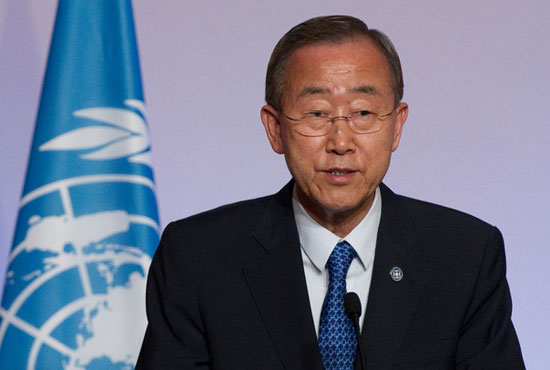Ban Ki-moon, former secretary-general of the United National, has had a thought. It is, unfortunately, not a good one. Acknowledging that the Oslo Accords are a failure (true), he then posits two things.
First, that the Israelis and Palestinians must recognize “the fundamental asymmetry between [them]. This is not a conflict between equals that can be resolved through bilateral negotiations, confidence-building measures or mutual sequencing of steps—the traditional conflict-resolution tools.” (Both untrue and true.)
Second, the negotiation failure is because “Israel has pursued a policy of incremental de facto annexation in the territories it has occupied since 1967, to the point where the prospect of a two-state solution has all but vanished.” (Just untrue.)
It is not a “conflict between equals,” but it is true that “confidence-building” and so forth will not work—because the Palestinians remain in a self-avowed state of war with Israel. It is the last remnant of the pan-Arab war against the Jewish state that began before 1948 and is now slowly resolving as follows: “Termination of all claims or states of belligerency and respect for and acknowledgment of the sovereignty, territorial integrity and political independence of every State in the area and their right to live in peace within secure and recognized boundaries free from threats or acts of force.”
Those words should sound familiar to Ban because they are from UN Resolution 242, adopted in the wake of 1967’s Six Day War. Starting with Egypt and Jordan, followed by the Sunni Gulf states, then Sudan and Morocco openly as well as other Arab and African countries quietly, the normalization movement represents precisely the “new approach” Ban seeks.
Countries that benefit from the new arrangement have been making it clear to the Palestinians that both Hamas and Fatah provide their own impediments to pan-Arab support. Nowhere does Ban mention that corruption and repression of their own people—as well as ongoing incitement to violence against Jews and “pay for slay” payments to convicted terrorists—have rendered the Palestinians unacceptable interlocutors to everyone in the region.
Notice that the countries that haven’t moved in toward Israel are precisely those decimated by Iran over the past two decades: Iraq, Syria and Lebanon (plus, of course, Hamas). Maybe, just maybe, Iran is part of the problem—but its various malign machinations receive no mention from Ban.
There is a clause in UN Res. 242 that requires “withdrawal of Israeli armed forces from territories occupied in the recent [1967] conflict.” (Note: not all the territories.) Under the terms of the Camp David Accords, Anwar Sadat expressly rejected retaking Gaza and Israel withdrew from the entire Sinai—more than 90 percent of the territory occupied after the 1967 conflict. Leading U.S. negotiator Eugene V. Rostow to say that Israel had complied with UN Res. 242 whether it eventually returned “all, some or none of the remaining territory.”
Rostow later added: “For reasons that remain compelling, 242 prescribes that Israel is under no obligation to withdraw from the West Bank or the Gaza Strip until Jordan makes peace.”
And even when Jordan did make peace decades later, the relevant treaty did not demand a return to Jordan of the “territories occupied in the recent conflict” because (a) Jordan did not want them, given its already-delicate population balance between Palestinians and East Bankers living together under a Hashemite king; and (b) Jordan’s 1949 occupation and 1950 annexation of the territory was illegal. Ban might recall that only two UN member states recognized the Jordanian occupation: Britain and Pakistan.
So, who in Ban’s mind should get the disputed territory? The PLO? The organization was established in 1964 (before there were any Israel-administered territories) to overthrow the king of Jordan. In 1970, the PLO and PFLP had an uprising in Jordan, during which the king’s forces killed up to 15,000 Palestinian militants and civilians. Swaths of Palestinian towns and refugee camps, where the PLO had amassed weapons, were leveled. Jordan requested a show of force from the Israeli air force against Syria. Israel responded, earning the appreciation of Jordan’s King Hussein. But giving the PLO a state bordering Jordan would have been a clear recipe for disaster.
The Oslo Accords were an attempt to change the thinking, a desire Ban claims to share. Oslo attempted to create a purely interim step—it nowhere mentioned a Palestinian state, nor did it necessarily envision one. The “two-state solution” certainly isn’t in there. And today, there are three governing bodies in the space between the Jordan River and the Mediterranean Sea: Hamas, the Palestinian Authority (PA) and Israel. Which one will disappear to achieve two states?
Hamas and the PA agree that Israel has to go; Israel demurs. It is generally assumed that Gaza and the West Bank territory would conjoin and become a single PA-controlled governing entity. Well, May’s Hamas rocket war against Israel was, in no small part, intended to prove to Palestinians that Hamas is the more vigorous party and the one more likely to get rid of Israel than the PA. Hamas asserted its position in Jerusalem, including on the Temple Mount—long the purview of the PA. What if there were Palestinian elections and Hamas won? That is precisely what led PA President Mahmoud Abbas to cancel the recent scheduled election.
Finally, Ban errs in his conclusion: “An end to the [Israeli] occupation must remain the primary goal.”
The primary goal is a secure and recognized Israel, and the forward-looking states of the region are on their way to providing that. A secondary, though less realistic, goal is for the Palestinians to achieve a government that doesn’t threaten its own—or other—people. And third might be to rescue the northern tier of Arab states from Iranian influence.
A little help from the Ban Ki-moons of the world would be nice.






